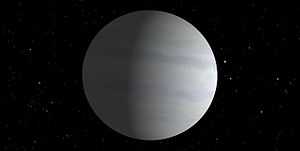Mu Arae b
| Extrasolar planet | List of extrasolar planets | |
|---|---|---|
 | ||
| Parent star | ||
| Star | Mu Arae | |
| Constellation | Ara | |
| Right ascension | (α) | 17h 44m 08.7s |
| Declination | (δ) | −51° 50′ 03″ |
| Apparent magnitude | (mV) | 5.15 |
| Distance | 50.6 ± 0.2 ly (15.51 ± 0.07 pc) | |
| Spectral type | G3IV–V | |
| Mass | (m) | 1.10 ± 0.01 M☉ |
| Radius | (r) | 1.36 ± 0.01 R☉ |
| Temperature | (T) | 5820 ± 40 K |
| Metallicity | [Fe/H] | 0.30 ± 0.01 |
| Age | 6.34 ± 0.40 Gyr | |
| Orbital elements | ||
| Semimajor axis | (a) | 1.497[1] AU (223.9 Gm) |
| Periastron | (q) | 1.304 AU (195.1 Gm) |
| Apastron | (Q) | 1.689 AU (252.6 Gm) |
| Eccentricity | (e) | 0.128[1] |
| Orbital period | (P) | 643.25 ± 0.90[1] d (1.7611 y) |
| Argument of periastron |
(ω) | 22.0 ± 7.0[1]° |
| Time of periastron | (T0) | 2452365.6 ± 12.6[1] JD |
| Semi-amplitude | (K) | 37.78 ± 0.40 m/s |
| Physical characteristics | ||
| Minimum mass | (m sin i) | 1.676[1] MJ (533 M⊕) |
| Discovery information | ||
| Discovery date | December 12, 2000 | |
| Discoverer(s) | Butler, Marcy | |
| Discovery method | Doppler Spectroscopy | |
| Discovery site | California, | |
| Discovery status | Published | |
| Other designations | ||
| HD 160691 b | ||
| Database references | ||
| Extrasolar Planets Encyclopaedia | data | |
| SIMBAD | data | |
| Exoplanet Archive | data | |
| Open Exoplanet Catalogue | data | |
Mu Arae b (also referred to as HD 160691 b) is an exoplanet orbiting the star Mu Arae of the constellation Ara. It is at least one and a half times the mass of Jupiter, and its orbital period is 643.25 days. The discovery of this planet was announced on December 12, 2002, and was originally thought to be on a highly eccentric orbit.[2] The latest models of the its planetary system, which has four known planets, give a lower eccentricity orbit.[1] Although the planet itself is likely to be a gas giant with no solid surface, the orbital distance of 1.497 astronomical units from its star puts it within the habitable zone of its planetary system. As a result, large satellites, if they exist, of the planet, could potentially support life. However, it may not receive enough ultraviolet light for abiogenesis to proceed.[3] Furthermore, it is not clear that Earth-size moons can actually be formed in the environment around a gas giant planet.[4]
References
| Wikimedia Commons has media related to Mu Arae b. |
- ↑ 1.0 1.1 1.2 1.3 1.4 1.5 1.6 Pepe, F.; Correia, A. C. M.; Mayor, M.; Tamuz, O. et al. (2007). "The HARPS search for southern extra-solar planets. VIII. μ Arae, a system with four planets". Astronomy and Astrophysics 462 (2): 769–776. arXiv:astro-ph/0608396. Bibcode:2007A&A...462..769P. doi:10.1051/0004-6361:20066194.
- ↑ Butler, R. Paul; Tinney, C. G.; Marcy, Geoffrey W.; Jones, Hugh R. A. et al. (2001). "Two New Planets from the Anglo-Australian Planet Search". The Astrophysical Journal 555 (1): 410–417. Bibcode:2001ApJ...555..410B. doi:10.1086/321467.
- ↑ Buccino, Andrea P.; Lemarchand, Guillermo A.; Mauas, Pablo J. D. (2006). "Ultraviolet Radiation Constraints around the Circumstellar Habitable Zones". Icarus 183 (2): 491–503. arXiv:astro-ph/0512291. Bibcode:2005astro.ph.12291B. doi:10.1016/j.icarus.2006.03.007.
- ↑ Canup, R.; Ward, W. (2006). "A common mass scaling for satellite systems of gaseous planets". Nature 441 (7095): 834–839. Bibcode:2006Natur.441..834C. doi:10.1038/nature04860. PMID 16778883.
| ||||||||||
Coordinates: ![]() 17h 44m 08.7s, −51° 50′ 03″
17h 44m 08.7s, −51° 50′ 03″
| ||||||||||||||||||||||||||||||||||||||||||||||||||||||||||||||||||||||||||||||||